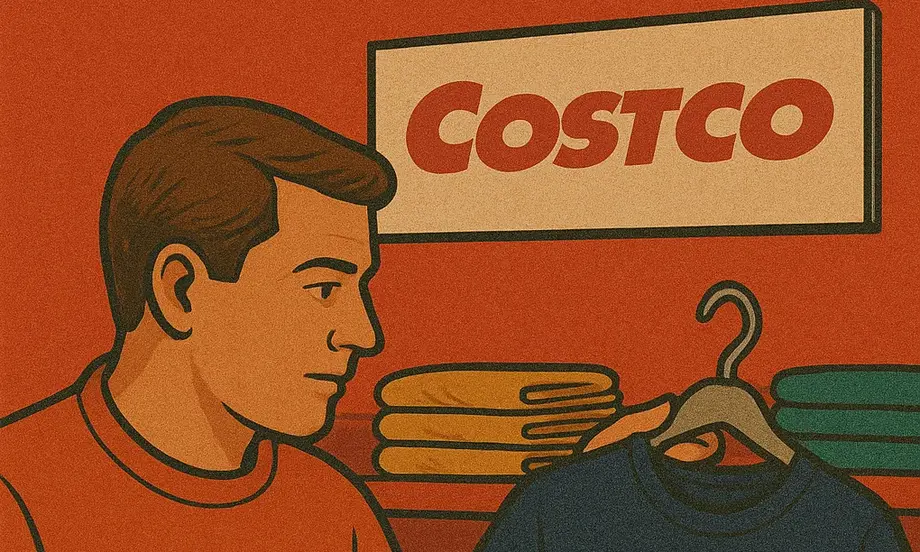The Fashion Giant You Never Expected: Costco’s $10 Billion Clothing Empire
Costco has quietly grown into one of the biggest clothing retailers in the world, with a nearly $10 billion apparel business that now surpasses major fashion brands like Gap, Calvin Klein, Tommy Hilfiger, Abercrombie and Fitch, and Old Navy. This wholesale member club known for $5 rotisserie chickens has become a formidable force in fashion through a unique strategy that combines private labels with brand partnerships.
The Numbers: A Fashion Powerhouse in Disguise
Over the past five years, Costco has grown its apparel sales by nearly 40%, outpacing competitors like BJ’s (28% growth) and Sam’s Club (21% growth). The company’s apparel segment is now larger than several major fashion retailers, proving that the wholesale club model can work exceptionally well in the clothing industry.
Costco’s success hinges on a mixed offering of its beloved private label, Kirkland Signature, along with popular brand name products. The company doesn’t carry many items in the store, but what it does have, it buys deep and can offer very low prices to consumers. This approach has created a treasure hunt appeal where customers never know what brands they might find, from Gap products to Lucky Jeans to Levi’s.
The Kirkland Signature Phenomenon
One of Costco’s secrets to success is its private label, Kirkland Signature, which was formed back in 1995 and has gained a cult-like following. The brand often utilizes popular brands to manufacture its own version, sometimes even advertising these partnerships like with Ocean Spray cranberry juice or Reynolds Aluminum Foil.
Kirkland Signature clothing has become a trend, especially among younger consumers who are proud to be value-conscious and find good deals. The brand has evolved from being known for a “dad chic” element to becoming cool through social media exposure. Consumers are now proud to wear sweatshirts and other clothing items with the actual Costco logo on them.
Strategic Brand Partnerships and Licensing
Most of what Costco does in apparel is partnerships with lines made specifically for the wholesale club. These Costco lines in branded apparel may be slightly different from the mainstream offerings in those brands’ stores, essentially creating diffusion lines that offer similar quality at lower prices.
Licensing is another way for big brands to get onto Costco’s shelves. A May 2025 report from Women’s Wear Daily revealed that the Saks Fifth Avenue brand name would be licensed to Centric Brands to sell men’s apparel at Costco, demonstrating how luxury brands are finding value in the wholesale club model.
The Treasure Hunt Merchandising Strategy
Costco’s merchandising is intentionally less streamlined, creating excitement and discovery for customers. Many times, customers will see particular brands in social media that Costco never sells regularly in their stores, appearing only in a handful of locations because they may have gotten an opportunistic deal.
This could involve special overruns from particular vendors, excess inventory from other retailers, or third-party purchases. This explains why items like Birkenstocks might appear on Costco’s website even though the company doesn’t sell directly to the wholesale club. The unpredictability creates a treasure hunt appeal that keeps customers coming back to see what new brands they might discover.
The Lululemon Lawsuit: A Silver Lining
Costco has been caught up in legal drama with its apparel business when Lululemon sued the company in 2025 for allegedly selling replicas of its clothing at cheaper price points. The lawsuit claims that Costco’s ambiguity in sourcing leads some consumers to believe that its products are being made by Lululemon.
However, experts suggest this could be a silver lining for Costco. The lawsuit has drawn enormous attention to the fact that Costco has all these clothing lines, essentially providing free advertising. As one expert noted, “It’s been one of the most fantastic advertising campaigns that Costco could hope for.” The lawsuit may also indicate that competitors are taking Costco more seriously as a fashion retailer.
Costco’s Unexpected Fashion Moment
What began as a lawsuit may evolve into a marketing win. By drawing new attention to its apparel lines, Costco is blurring the line between bulk retail and brand fashion—forcing traditional players to take notice. In today’s market, controversy can be the new catalyst for growth.
Discover Retail & Brand Strategy Jobs →The Costco Business Model: Volume Over Margin
Costco’s main source of income is from membership fees, which allows the company to keep prices extremely low. The company shifts enormous volume, and with low margins but enormous volume, it can generate significant profits. The savings from economies of scale, combined with membership income, are shared with consumers.
Costco’s gross margin has hovered around 10% over the past few years, compared to Target and Walmart’s 20-30% range. The company keeps its initial markup super low at around 14%, compared to the industry standard of about 50%. This disciplined approach to pricing is what makes Costco’s clothing so attractive to value-conscious consumers.
The Philosophy: Great Value at Every Price Point
What’s particularly interesting about Costco’s approach is that the same philosophy applies whether you’re buying a $5 item or a $10,000 bottle of wine. The company pushes up into really expensive items like diamond rings and premium wines, but the value proposition remains the same. You might pay $10,000 for a bottle of wine at Costco, but you’d probably pay $12,000 elsewhere, so it’s still great value for money.
This consistent approach to value has created a loyal customer base that trusts Costco to deliver quality products at competitive prices, regardless of the price point. The company’s 2024 annual report even stated that it may reduce prices or hold prices steady to drive sales and remain competitive, even if it negatively impacts margins.
Stock Performance and Future Outlook
Costco’s stock performance has been volatile in the short term, underperforming the S&P 500 over a one-year period despite a strong start in 2025. However, over the long term, Costco has been a strong performer, with shares up around 150% over the past five years.
The company has stuck to an aggressive expansion plan both domestically and globally, giving investors confidence that it has a runway for growth. The stock’s high price-to-earnings ratio reflects investor confidence, but it can also lead to increased volatility as investors hold the company to high standards.
Tariff Challenges and Adaptability
Like most retailers, Costco has been impacted by higher costs related to tariffs, but the company has an advantage. It has diverted some US-bound imports to clubs in other parts of the world, and because it doesn’t carry that many brands relative to retailers like Target or Walmart, it can swap out inventories pretty easily.
However, experts warn that a higher tariff environment will eventually catch up to Costco, forcing it to increase prices. The company’s ability to adapt its inventory and sourcing will be crucial in maintaining its competitive advantage.
The Bottom Line: A Fashion Retailer in Disguise
Costco’s clothing business success demonstrates how a wholesale club can become a major player in fashion by focusing on value, strategic partnerships, and creating a treasure hunt shopping experience. The company’s nearly $10 billion apparel business now rivals some of the biggest names in fashion, proving that the wholesale club model can work exceptionally well in the clothing industry.
The combination of Kirkland Signature private labels, strategic brand partnerships, and the treasure hunt merchandising strategy has created a unique shopping experience that keeps customers coming back. As competitors like Lululemon take notice and even file lawsuits, it’s clear that Costco has become a serious player in the fashion world, one that consumers love and competitors respect.




